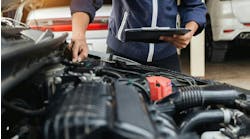In my last column I discussed the need for the collision estimator to serve as a professional salesperson and sales closer. To take that idea a step further, while also acknowledging that science is the foundation of collision estimating, what is often forgotten is that the estimating process is also an art – an art that involves an emphasis on understanding the customers' needs when they walk in your door.
The concept of collision estimating and repair is often viewed, simply, as the process of mixing the chemical formula of a pearl paint, when it should be considered more like the art of tinting and blending to match that beautiful color on the customer's car. We all know that a color as simple as white is not just white in the can. It contains many elements or toners to make up that simple white color, just as the art of estimating involves many elements to help you win the job.
In most cases, the customer's car is his second largest asset. Fifty percent of customers had that asset damaged by another individual. The art of convincing the customer that you and your shop can help make them whole again is important when trying to drive more business. Your job as an estimator is to reassure the customer that your shop can correctly and safely repair the vehicle, and that you will be the customer's trusted advisor throughout the process. The average customer is involved in an accident just once every seven years and is lost as to what they need to do. You are the expert. Every new prospect that walks in the door provides you an opportunity to build trust from the start – in you and your shop as the customer's go-to collision repair organization.
If today's customers expect professionalism, quality and safety in the repair of their cars, how do you set your shop apart from the rest? Start with a professional approach to estimating – the right technology, tools and training, and add in the art of estimating, which entails creating value from the intangible. Ask questions with a purpose. Begin with the end in mind. How you do that in sales terms is called qualifying. In estimating terms, it means that you talk with your customer: explain that the car tells a story about how it was damaged (science). Draw the customer out to understand what happened in the accident, and focus on active listening to help you build a relationship of trust, as well as diagnose additional damage. Develop a list of questions and listen carefully to the answers for use later when asking for the keys.
Very few customers arrive at your front door because they want to be there. Most arrive because someone damaged their car. Understand the emotions involved, even if they damaged their own car. Multiply that emotional effect if the damage is someone else's fault. Most estimators tend to want to start by analyzing the damage to the vehicle, and in doing so, they neglect to assess the condition of the customer, including their wants and needs.
Educate and explain to your customer what happens in the collision repair process. Our everyday procedures and industry terms may be a language they do not comprehend. Don't expect them to be comfortable navigating this unfamiliar process.
In collision repair, no two cars are damaged the same way, and no two cars have the same owner personality type or the same facts of loss. To set yourself up for success as an estimator – across all variables – ask questions and keep asking as you learn what's important to the customer. Set a level playing field by understanding your customer, and you will find that you will fix more cars and retain more happy customers.
Contact info: [email protected]


